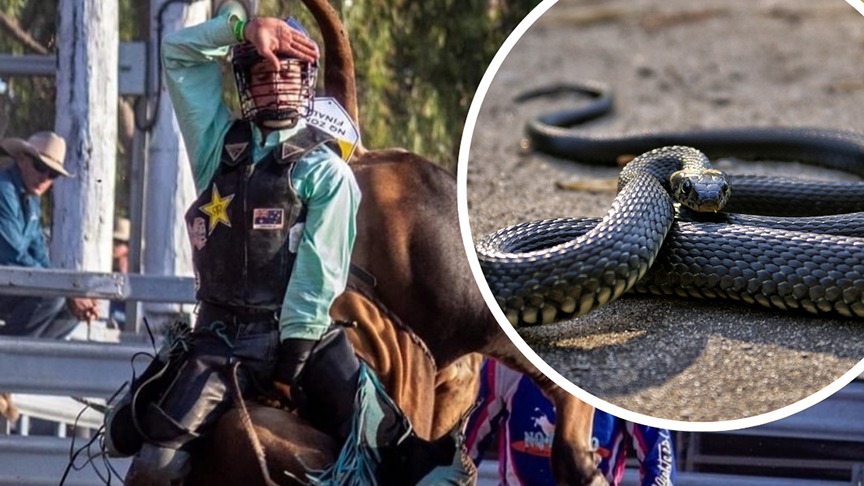
A young cowboy, who is normally cool under pressure, was scared for his life after he was bitten by a snake, while clearing a rural property in outback Queensland.
Tristan Pye, 18, was part of a working bee, helping others clean up bushland near Einasleigh, approximately 250km southeast of Cairns, in readiness for the small community’s famous Easter rodeo and races.
One afternoon at the start of March, the teen who is a regular on the Far Northern bullriding circuit, was pushing an old herbicide tank onto the back of a ute, when a black snake shot out and bit him on the ankle.
‘I just jumped down off the loading ramp and told everyone I’d just been bitten by a snake,’ he said.
‘I looked down where I was standing, and there he was, just sitting there.’
Like much of Far North Queensland, Einasleigh is home to some of most venomous species of snakes in the world.
This includes eastern brown snakes, taipans, death adders, and king brown snakes.
A bite from any of these snakes can be fatal, if medical care cannot be immediately reached.
Tristan didn’t have enough time to properly identify the snake that bit him, but said it was black-coloured.
‘It was a bit scary at the start,’ he said.
‘All I saw was this black snake, and thought ‘oh no,’ thinking I was about to die in five minutes.’
The bite was later found to be a ‘dry bite,’ in that the snake did not inject any venom into Tristan’s body. The snake’s behaviour is often a warning.
Tristan said his mates sprang into action to administer first aid.
‘My mate tied a belt around my leg – I later found out that’s not what you’re supposed to do – and drove me into the local health clinic,’ he said.
‘The nurse, she just wrapped my leg up with some bandages, and we called the Royal Flying Doctor Service, and they arrived within 30 minutes.’
He recalled his leg being excruciatingly itchy, a localised reaction of his body to the snake bite.
‘The initial bite hurt for about five minutes – it was burning for a little bit, and then it just went itchy,’ he said.
‘I could not sit still; how itchy it was.
‘It was so extremely itchy, everyone thought I was in pain, because of how much I was moving around.’
Tristan was flown to Cairns Airport, then driven in an ambulance to Cairns Hospital’s Emergency Department.
‘I was given fluids, and they monitored me overnight, in case there was any venom in me,’ he said.
‘I was told the itchiness was an allergic reaction to snake saliva, so I have to be especially careful not to get bitten again.
‘After 12 hours, I was OK to leave the hospital, the next morning.’
Cairns Hospital toxicologist Dr Shannon Baso said Tristan was lucky the snake’s bite did not include venom, which can cause immediate nausea, vomiting, numbness, weakness, difficulty breathing, possible paralysis and ultimately death.
‘When you are bitten by a snake, it is vital that you try not to move,’ she said.
‘This slows down the spread of venom through the body’s lymph system and allows you more time to reach medical care to potentially receive antivenom.
‘The worst thing you can do is jump up and down, run to the car.
‘The best thing you can do once you are out of danger from the snake, is not move your muscles, not flex your ankle if you’ve been bitten on the leg – just lie really still and try and be really calm; and get to the nearest medical facility, wherever you are.’
Dr Baso said anyone bitten by a snake should also be immediately fitted with a pressure immobilisation bandage, or – at a pinch – a shirt torn into shreds to make a temporary bandage that can be wrapped around an affected limb.
‘A belt wouldn’t work, because it’s too hard to use it to cut off anything flowing through your body, she said.
‘If you are out working in the bush, you should have a first aid kit with crepe bandages you can use; or you can tear up a shirt to make your own bandages.
‘Start just above the bite and wrap down the leg, then back up again.
‘These bandages don’t need to be very tight, and they shouldn’t be used to cut off circulation.
‘They should be about the same tightness as for a sprained ankle, to stop the flow of lymph not blood.’
A week after his snake bite, Tristan said his leg was still sore, with his foot heavily bruised.
‘My foot went all purple and bruised up with different colours. I can only just start to walk properly now,’ he said.
He said he was thankful he was able to reach emergency care so quickly, and grateful to emergency services and Cairns and Hinterland Hospital and Health Service medical staff who treated him.
‘If anyone is bitten by a snake, my best advice is stay calm – that’s what everyone was telling me to do, the whole time, no matter how scary it was,’ he said.
‘Thanks heaps to everyone who helped me along the way.’
For more information, see the Queensland Poisons Information Centre's page on treating snake bites.